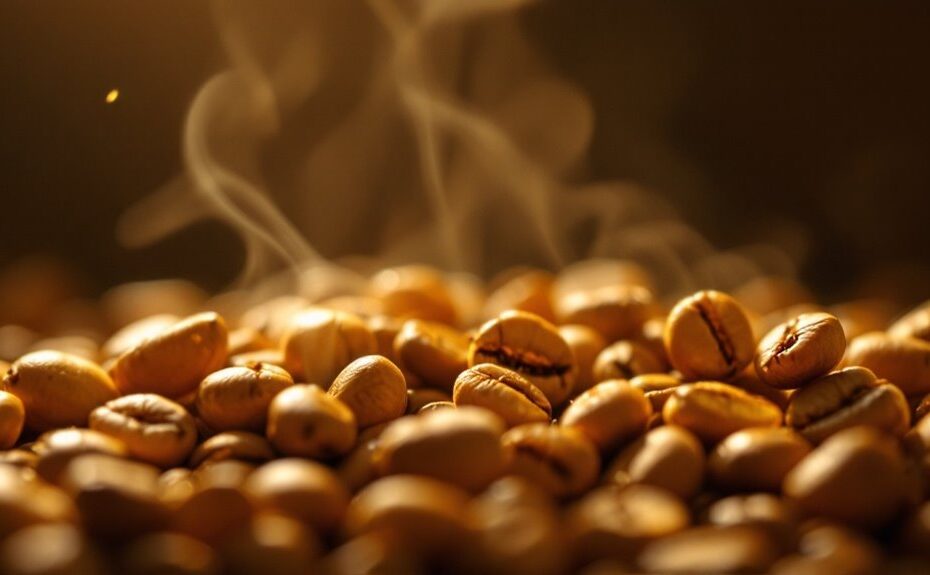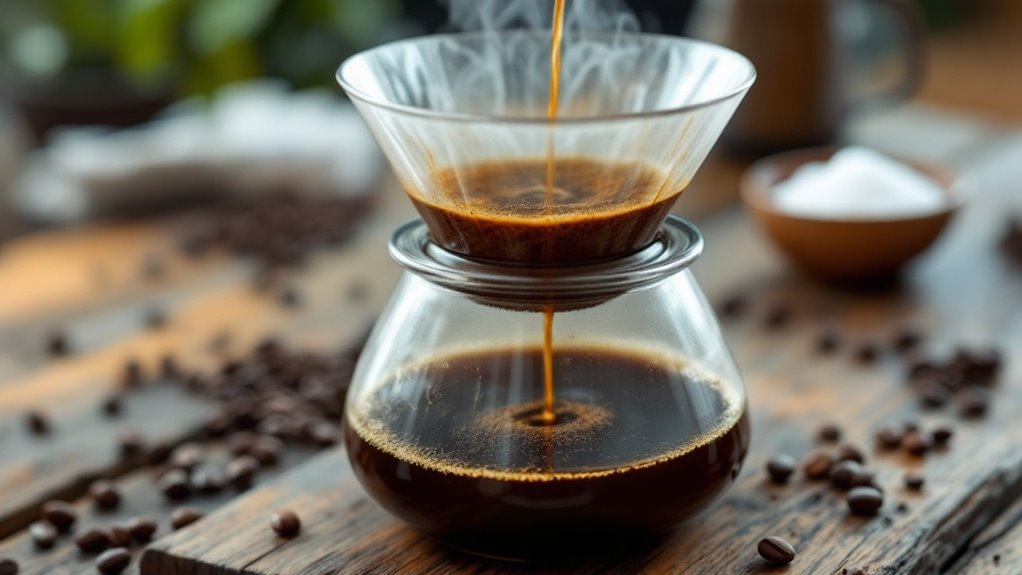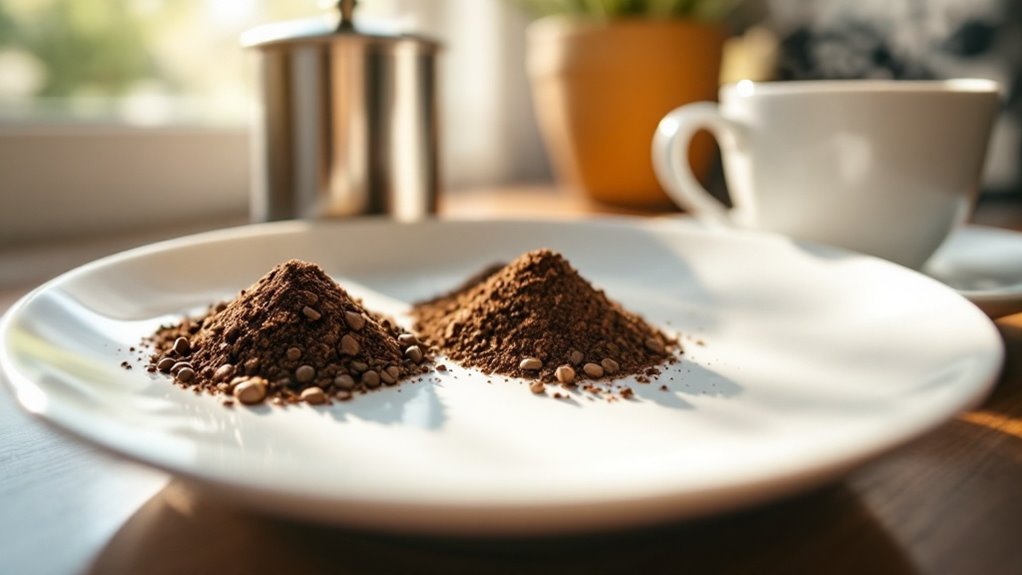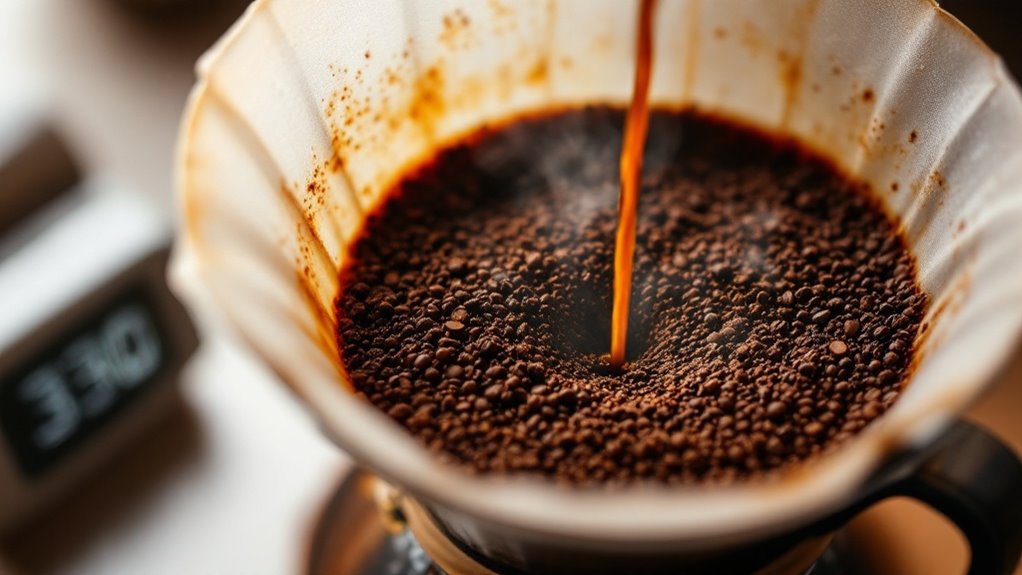







When you roast coffee, the Maillard reaction transforms the beans, creating the flavors you love. It's a chemical dance between amino acids and sugars, happening between 140°C and 165°C, that produces hundreds of aroma compounds. Think caramel, chocolate, and nutty notes—all born from this process. But it's not just about flavor; melanoidins formed during this reaction also shape the coffee's color, body, and even crema. The catch? The outcome hinges on factors like temperature, time, and bean composition. So, what happens when these variables shift, and how does it change your cup? The answer might surprise you.
Key Takeaways
- The Maillard reaction occurs between amino acids and sugars at 140°C–165°C, creating complex flavors like caramel, chocolate, and nutty notes in coffee.
- It generates over 800 aroma compounds, including pyrazines and furans, which define the coffee's sensory profile during roasting.
- Melanoidins formed during the reaction enhance color, body, and crema stability, contributing to the coffee's texture and mouthfeel.
- The reaction begins in the caramelization phase and intensifies during browning, balancing sweetness, acidity, and bitterness in the final roast.
- Factors like bean density, moisture, and roasting temperature influence the Maillard reaction's intensity and the resulting flavor complexity.
The Science Behind the Maillard Reaction
The Maillard reaction is a cornerstone of coffee roasting, transforming raw green beans into aromatic, flavorful coffee through a complex interplay of chemistry. This non-enzymatic browning reaction occurs when amino acids and reducing sugars interact under heat, typically between 140°C and 165°C (284°F and 329°F). As bean temperature rises during the roasting process, these chemical reactions generate a cascade of flavor compounds and aromatic compounds, including pyrazines, furans, and thiols, which impart notes of caramel, chocolate, and nuttiness. The browning phase is critical, as it marks the peak of the Maillard reaction, where melanoidins—complex polymers—form, contributing to coffee's rich color, enhanced mouthfeel, and stable crema in espresso. The reaction's intensity depends on factors like moisture content, roasting temperature, and time, which influence the balance of sweetness, acidity, and bitterness. By controlling these variables, you can manipulate the Maillard reaction to achieve desired flavor profiles, ensuring the development of over 800 aroma compounds that define specialty coffee. Understanding this process allows you to optimize the roasting process, revealing the full potential of the beans.
Phases of Coffee Roasting and the Maillard Reaction
Understanding the phases of coffee roasting reveals how the Maillard reaction shapes flavor development. The process begins with the drying phase, where green coffee beans lose moisture and turn yellow, preparing them for subsequent chemical reactions. This phase accounts for about 40% of the total roast time. As temperatures rise to 140°C–165°C (284°F–329°F), the Maillard reaction initiates, marking the caramelization phase. Here, amino acids and reducing sugars in the beans react, producing over 800 aroma compounds that contribute to flavors like caramel, chocolate, and nuttiness. Simultaneously, the beans undergo browning, a visual indicator of the reaction's progress. The Maillard reaction slows as the beans approach the first crack, a critical point signaling the shift to the development phase. During this stage, flavor complexity is finalized, balancing sweetness, acidity, and body. Roasters meticulously monitor the Maillard reaction, as its duration and intensity directly influence the coffee's sensory profile. By controlling these phases, you can optimize the interplay of chemical reactions to achieve desired flavor outcomes.
How the Maillard Reaction Shapes Coffee Flavor
At temperatures between 140°C and 165°C (284°F and 329°F), amino acids and reducing sugars in coffee beans undergo the Maillard reaction, generating over 800 aroma compounds that define the beverage's flavor profile. These compounds create nutty, chocolatey, and caramel-like notes, which are central to coffee's sensory appeal. The Maillard reaction also produces melanoidins, high-molecular-weight polymers that enhance the coffee's body and mouthfeel, contributing to its rich texture and stabilizing crema in espresso. The duration and intensity of the Maillard reaction directly influence the roast level and flavor complexity. Shorter reactions yield softer, less developed flavors, while extended reactions deepen browning, intensify sweetness, and amplify bitterness, resulting in a more robust and layered flavor profile. By modulating the Maillard reaction, you control the balance of acidity, sweetness, and bitterness, tailoring the coffee's character to specific preferences. The interplay between amino acids and reducing sugars during this reaction is critical, as it determines the formation of key aroma compounds and melanoidins, which collectively shape the coffee's sensory attributes. Understanding this process allows you to optimize roast profiles for desired flavor outcomes.
Factors Influencing the Maillard Reaction in Roasting
Bean density and moisture content play a pivotal role in how the Maillard reaction unfolds during coffee roasting. Denser beans with lower moisture content require higher roasting temperatures to initiate the reaction, while less dense, high-moisture beans react more quickly. The roasting temperature, typically between 140°C and 165°C (284°F and 329°F), directly influences the reaction's intensity and duration. Higher temperatures accelerate the Maillard reaction but risk overdevelopment, while lower temperatures prolong it, enhancing flavor complexity. The type of roaster you use—whether drum or air—also affects heat distribution, altering the reaction's progression and final flavor profile. Altitude and environmental humidity further modify roasting conditions; high-altitude beans often have lower moisture content, while humid environments can slow the reaction. The chemical composition of green beans, particularly their sugar and amino acid content, determines the reaction's potential. Higher sugar and amino acid levels yield more melanoidins, contributing to richer, more complex flavors. By controlling these variables, you can optimize the Maillard reaction to achieve desired flavor outcomes in your roasted coffee.
The Role of Melanoidins in Coffee Characteristics
Melanoidins, formed through the Maillard reaction, play a critical role in shaping the sensory and functional properties of roasted coffee. These high-molecular-weight compounds contribute to the brown color and roast flavor, which intensify with darker roasts due to the formation of hundreds of complex chemical reactions. During coffee roasting, melanoidins enhance the texture and mouthfeel by increasing the viscosity and body of brewed coffee, creating a richer and more aromatic and flavorful experience. They also stabilize crema in espresso, improving foam structure and visual appeal. Beyond sensory attributes, melanoidins exhibit antioxidant and anti-inflammatory properties, potentially offering health benefits. The desired roast level directly influences melanoidin concentration, with darker roasts producing higher levels, which deepen the browning and amplify flavor complexity. Understanding the role of melanoidins helps you appreciate how the Maillard reaction transforms raw coffee beans into a product with distinct color, flavor, and functional characteristics, ultimately defining the quality of your cup.
Disclosure: As an Amazon Associate, I earn from qualifying purchases.




